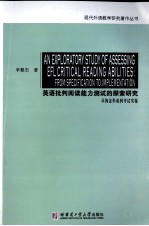图书介绍
英语批判阅读能力测试的探索研究 从构念形成到考试实施PDF|Epub|txt|kindle电子书版本下载

- 李慧杰著 著
- 出版社: 哈尔滨:哈尔滨工业大学出版社
- ISBN:9787560330600
- 出版时间:2010
- 标注页数:249页
- 文件大小:41MB
- 文件页数:257页
- 主题词:英语-阅读教学-教学研究
PDF下载
下载说明
英语批判阅读能力测试的探索研究 从构念形成到考试实施PDF格式电子书版下载
下载的文件为RAR压缩包。需要使用解压软件进行解压得到PDF格式图书。建议使用BT下载工具Free Download Manager进行下载,简称FDM(免费,没有广告,支持多平台)。本站资源全部打包为BT种子。所以需要使用专业的BT下载软件进行下载。如BitComet qBittorrent uTorrent等BT下载工具。迅雷目前由于本站不是热门资源。不推荐使用!后期资源热门了。安装了迅雷也可以迅雷进行下载!
(文件页数 要大于 标注页数,上中下等多册电子书除外)
注意:本站所有压缩包均有解压码: 点击下载压缩包解压工具
图书目录
Chapter 1 Introduction1
1.1 Background:Reformation Context of EFL Testing2
1.2 Reasons for Assessing Critical Reading Abilities6
1.3 The Nature of Critical Reading Test(CRT)11
1.4 The Objectives of the Study13
1.5 Preview of the Chapters14
Chapter 2 Literature Review17
2.1 Definitions of Critical Reading18
2.2 Critical Readirg Abilities(CRA)35
2.3 Theoretical Underpinnings for Critical Reading38
2.4 Three Critical-reading Oriented Tests49
2.5 Critique on English Reading Test Methods53
2.6 Elements in Developing Communicative Reading Tests56
Chapter 3 The Blueprint of an EFL Critical Reaaing Test67
3.1 Framework of Being Critical in EFL Reading68
3.2 Taxonomy of EFL Critical Reading Abilities69
3.3 CRA Test Focus Inventory73
3.4 Specification for an EFL Critical Reading Test78
3.5 CRT Prototype Paper84
Chapter 4 Research Methodology88
4.1 A Three-stage Research Design Based on the CRA Blueprint89
4.2 Research Questions90
4.3 Subjects and Participants92
4.4 Research Instruments96
4.5 Research Administration102
Chapter 5 Data Analysis:Results,Findings and Discussion109
5.1 Questionnaire Data111
5.2 Test Score Data154
5.3 Interview Data161
5.4 Overall Analysis of the Data169
Chapter 6 Conclusions,Implications,and Limitations172
6.1 Necessity and Feasibility of Critical Reading Tests173
6.2 Answers to the Research Questions176
6.3 Modification to the CRT Specification183
6.4 Implications of the Research184
6.5 Contributions of the Study190
6.6 Lmitations ofthe Study192
6.7 Future Research Orientations193
Appendixes196